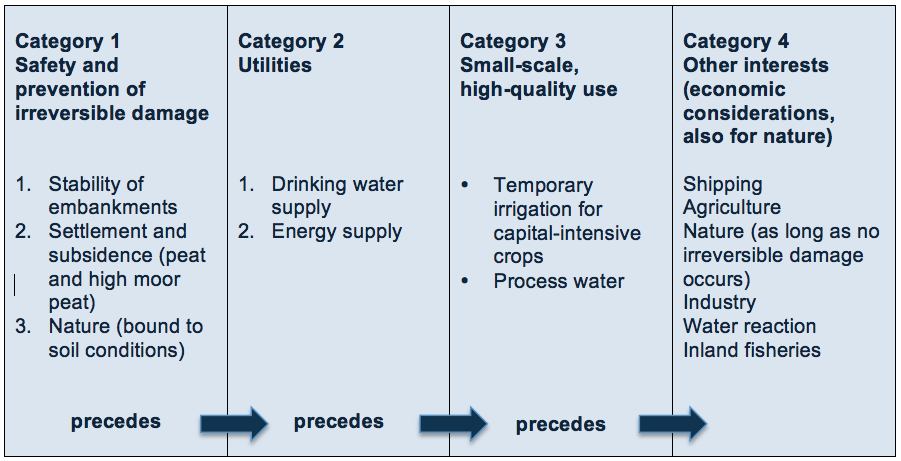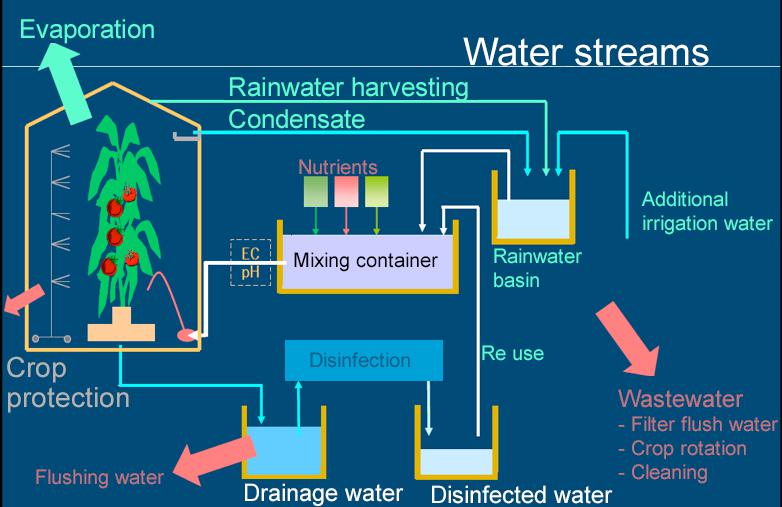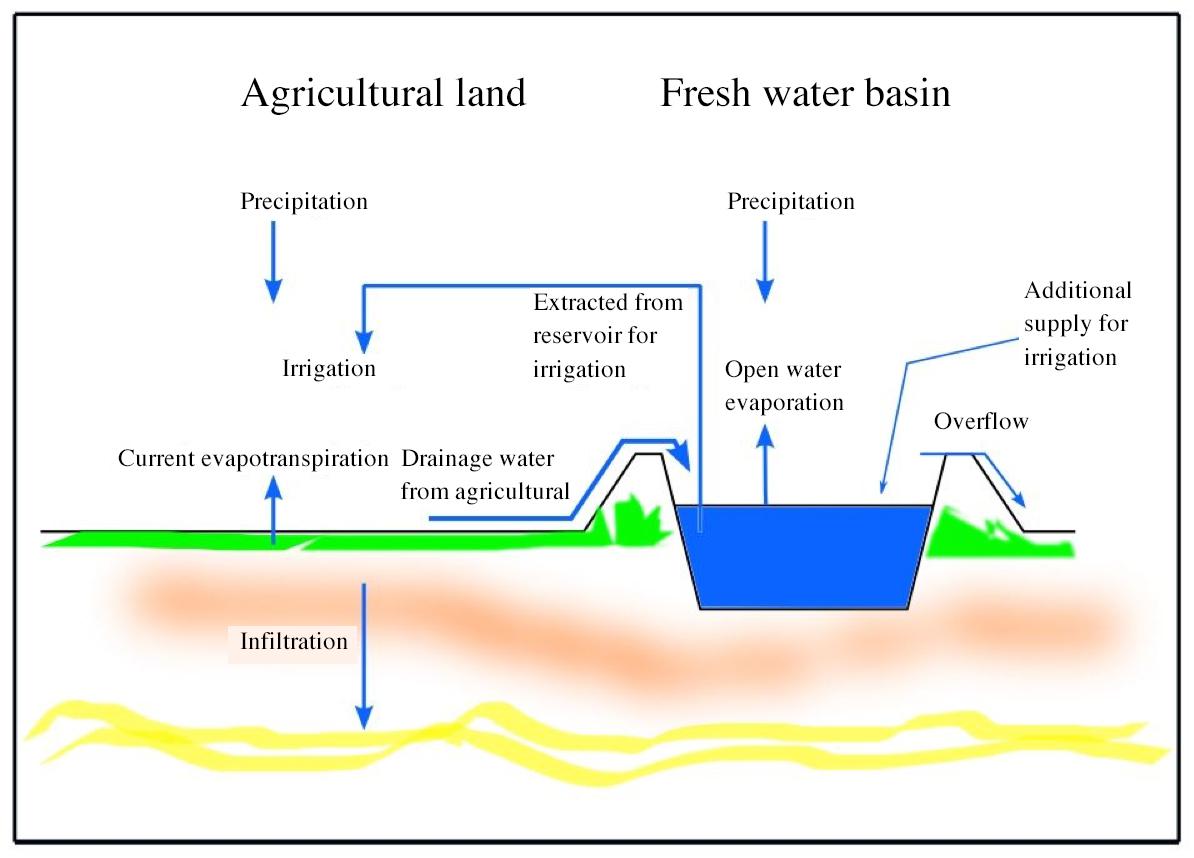Company water reservoirs
This fact sheet outlines water reservoir solutions for the greenhouse horticulture and field crop sectors. Water reservoirs on private plots reduce the reliance of farmers and horticulturists on water managers for access to water of sufficient quality and quantity.
|
Thema |
Zoetwatervoorziening, Delta facts, English versions |
|
Tags |
|
|
Downloads |
- INTRODUCTION
- RELATED TOPICS AND DELTA FACTS
- STRATEGY: HOLD, STORE, SUPPLY
- SCHEMATIC
- PERFORMANCE
- COSTS AND BENEFITS
- TECHNCAL SPECIFIATIONS
- GOVERNANCE
- FIELD EXPERIENCE (NATIONAL AND INTERATIONAL)
- OVERVIEW CURRENTLY ACTIVE PROJECTS AND RESEARCH
- KNOWLEDGE GAPS
Introduction
Water reservoirs on private plots reduce the reliance of farmers and horticulturists on water managers for access to water of sufficient quality and quantity. And while construction of water reservoirs for the greenhouse horticulture sector is common practice, the high costs associated with it have held back mainstream adoption in the field crop sector in the Netherlands. Given the changing climate, however, this may change in the future. This fact sheet outlines water reservoir solutions for the greenhouse horticulture and field crop sectors.
Related topics and Delta Facts
Topics: Water storage, holding water, storing water, water conservation, water basin
Delta facts: Pricing of water for agriculture; Soil moisture-based irrigation; Effects of climate change on agriculture; Effectiveness of water intake; Controlled drainage; Salt-tolerant crops
Strategy: hold, store, supply
The concept of company water reservoirs is a strategy of supplying water of sufficient quantity and quality from rainwater that is held for that purpose.
Water storage on private plots makes farmers and horticulturists less dependent on water suppliers and water managers for their water needs. As climate change manifests itself in more extreme weather events such as hotter summers and more frequent and severe droughts, it increases the likelihood and extent of drought damage. The demand for water intensifies – also from other sectors – in the face of an ever-dwindling supply and given the low priority of Agriculture on the Priority List (see Figure 1), it does yield uncertainty in agriculture and horticulture, as they are dependent on the water manager for water supply.

Figure 1. The National Priority List (Source: National Water Plan 2009-2015)
Schematic
Water storage in the greenhouse horticulture sector consists of a virtually closed system that enables the efficient use of water and nutrients. Rainwater basins are used to capture and store rainwater. As the water in the basins is used up, the basins are replenished by groundwater desalinated by reverse osmosis. The saline brine that is discharged during the desalination process is then infiltrated into deep saline aquifers. This process is currently constrained by the policy restrictions imposed upon it by the Water Framework Directive. Figure 2 shows the water streams in greenhouse conditions.

Figure 2. The water streams and the role of the rainwater basin in the advanced greenhouse sector (Source: van Os, 2010)
The field crop sector is currently exploring solutions to ensure a steady supply of water for crops using an efficient ground and surface water system. During dry periods, ground or surface water is used as a source of irrigation water. Water storage on plots offers a solution for reducing reliance on water supply. Figure 3 show a schematic of water storage in open field crop cultivation.

Figure 3. Water storage in open field crop cultivation (Source: Van Bakel, 2009)
Performance
Greenhouse horticulture sector
In a normal year, water consumption is less than 10,000m3/ha, and with a storage capacity of 500-1000m3/ha, almost all demand for water can be met by meteoric water. In an extremely dry year like 1976, however, water demand can rise by 16%, while precipitation could drop by 60%, in which case a storage capacity of 5,000m3/ha would be required. This is not economically feasible; moreover, it would take several winters of heavy precipitation to refill the reservoirs, thus perpetuating this sector’s reliance on the water manager for its surface water needs and on groundwater, tap water or reverse osmosis water (Voogt 2011). Figure 2 shows how the advanced horticulture sector recirculates and reuses all existing water resources to reduce its water usage.
Field crop sector (see Figure 3)
The Netherlands has a mean annual rainfall of 750mm and 400mm evapotranspiration, with approximately 120mm precipitation deficit in the summer months and 240mm annual runoff. This indicates that collecting and storing the runoff on private plots during the winter months will help make up the precipitation deficit in the summer months. This is achieved by building water basins.
Costs and benefits
Greenhouse horticulture sector
The most commonly used systems are foil basins and water storage silos with annual costs of € 13 and € 8 per m3, respectively, for a storage capacity of 1000m3. More cost-effective subsurface water storage systems for greenhouse applications are available for areas where land costs are high.
| System | Capacity in m³ | Investment in Euro | Depreciation in % | Plot size in m² | Annual costs in Euro | Annual costs in Euro/m³ |
| Foil basin | 1000 | 9,953 | 15 | 850 | 13,008 | 13 |
| Silo | 1000 | 14,928 | 10 | 450 | 7,914 | 8 |
| Water block | 1000 | 118,433 | 5 | 0 | 11,843 | 12 |
| Excavated basin | 10,000 | 35,000 | 10 | 5,000 | 4,500 | 0.45 |
Table 1. Costs of four types of water storage systems. Investment costs: earthworks, piling, foundation or other necessary construction, and films used. Annual costs: depreciation and 5% interest on the investment, yield loss across the plot size required. Source: van Steekelenburg 2010. Note: The cost estimate for the excavated basin does not include the cost of measures for preventing loss of water to the subsurface.
Field crop sector
Water storage costs include:
- Production loss due to conversion of the agricultural land into fresh water basin, which in the case of pastoral land is € 2,000/ha;
- Interest and depreciation of the construction costs.
The annual cost for a 2m excavated basin is € 0.45 per m3 of reservoir capacity (see Table 1). Due to the current price level of agricultural products, water storage is not profitable for arable and pastoral farming, as water storage and irrigation costs will exceed the additional returns generated (for calculation, see box 1), but it may very well be one of the more practical solutions if climate change contributes to more drought damage and/or higher prices for agricultural products. It is also a reliable solution for field crop farming, if there are no alternatives to fresh water supply (van Bakel, 2009).
|
Box 1. Calculation of water basins for field crop farming |
Technical specifications
(Rain)water storage is the rule in the greenhouse horticulture sector and the exception in the arable and pastoral farming sector. The greenhouse horticulture sector places high demands on the water quality. The groundwater in the Dutch lowlands is highly saline, making rainwater preferable to surface water. Availability of water is a requirement, especially in substrate farming, where water with dissolved nutrients is administered to an artificial growth medium several times a day. The excess is captured, disinfected, adjusted to the appropriate nutrient concentration and administered again (see Figure 1). The growth medium has such a low water-holding capacity that disruption of the water supply will result in large – and potentially catastrophic – production losses in a matter of hours. Optimising the growth conditions will result in very high yields, as well as exceptionally high water productivity. Investment in water storage accounts for a small fraction of the overall production cost.
In field crop farming the soil’s own water-holding capacity is used. The need for irrigation arises when prolonged periods of drought and rising precipitation deficit occur. Initially, only soils with limited water-holding capacity and/or drought-sensitive crops are irrigated. Water storage on private plots can be economically viable when ground or surface water is difficult or impossible to supply or if it is unavailable for irrigation.
Adviescommissie Water voor de Veenkoloniën (2012) [Water Advisory Committee for the Peat Districts] states that the profitability or non-profitability of company water reservoirs in the Peat Districts depends on land value and agricultural returns: “Analysis of the current peat district development plan and the € 25,000 land value shows that a small positive return can be expected (Aequator, 2009). A higher land value will yield a negative return. As such, the high level of costs can be regarded as an opportunity and a challenge to make water reservoirs profitable by integrating different functions, e.g. energy recovery or greening of the new CAP [Common Agricultural Policy]”.
Governance
Greenhouse horticulture sector
The Greenhouse Horticulture Decree mandates the construction of water basins. Effective 1 January 2010, all greenhouse companies must have a water basin of at least 500m3/ha. Tightening of the so-called Brine Policy may result in horticulturists being forced to expand their storage capacity. At present, horticulturists discharge the saline brine, which is produced by reverse osmosis during the desalination process, deep into the subsurface (200m). This process has been prohibited by the Province of Zuid-Holland since 2013 (pursuant to the Soil Protection Discharge Decree of the Soil Protection Act and the EU Water Framework Directive), and horticulturists must look for alternative solutions. One solution is to expand the storage capacity.
Field crop sector
The relevance of the option of water storage on private plots is largely determined by the ability to have water supplied at lower costs. LTO is committed to securing these water supplies in the future. It remains to be seen whether this is feasible in a changing climate. Reserving land for water storage on private plots may possibly be regarded as a so-called ‘blue service’.*
*) Dutch authorities can grant an allowance to agricultural and private land users for providing ‘blue services’; these are measures that contribute to sustainable water management, e.g. for the storage and purification of water, and for counteracting dehydration (http://www.blauweengroenediensten.nl/)
Field experience (national and international)
Greenhouse horticulture sector
This sector leads the world in almost every respect, thus also in water storage.
Field crop sector
This sector seemingly lags behind other EU countries in terms of water storage. Water storage is increasingly used on private plots in neighbouring countries such as Belgium and United Kingdom, and even in developing countries with drier growing seasons there are many privately owned water storage reservoirs, especially at locations where no large-scale irrigation systems are installed, This may partly explain the relative difference with the Netherlands: Dutch farmers have historically had abundant water sources for irrigation, thanks to the temperate climate with a relatively even distribution of rainfall throughout the year. Other reasons are the topography and the available space; a hilly landscape provides the perfect setting for water storage (with the need to pump water in or out); moreover, space is virtually scarce everywhere in the Netherlands.
Overview currently active projects and research
Greenhouse horticulture sector
The adoption of water storage in this sector is so commonplace that horticulturists and the supplying industry are themselves the sources of innovation. Scientific research is continuously being conducted into further increasing the water productivity. One of the developments to come out of such research is the recovery of condensate (see the Watergy project).
Field crop sector
Research in this area consists mainly of model studies into the relevance of water storage for different climate scenarios and crop patterns (van Bakel, 2007 a and b). A demo project involving research on storage on plots and storage in larger areas is currently underway in the management area of the Groot Salland water board. Aside from water supply, this option can also be used to reduce peak discharge (water storage).
Commissioned by the Aa en Maas water board an exploratory study was conducted into the feasibility of the ‘Waterhouderij’ (Water Husbandry) concept. The purpose of Waterhouderij is to achieve greater self-sufficiency in water supply from an economic perspective. The study examined the effectiveness and feasibility of local buffering of water. Waterhouderij on local scale has proved financially infeasible, given the current land use, but it is expected to be viable in the future (Arts, 2011).
| Project | Parties involved | Contact person | Location |
| Water storage on farms. Averheino demo project | Wageningen UR, Groot Salland Water Board | Averheino | |
| The Waterhouderij as water manager in the region. | Aequator | M.P.T. Arts Aequator Groen & Ruimte | Miscellaneous |
Knowledge gaps
Increased adoption of water storage in the field crop sector may have repercussions for regional water managers. After all, storage and subsequent use will result in increasing evaporation as net discharge from agricultural companies decreases. On the other hand, there is a risk that extreme precipitation will increase runoff when the storage is full and all the precipitation is discharged. Research question: to what extent will company water storage result in greater extremes in discharge to the main water system.

 English resume
English resume